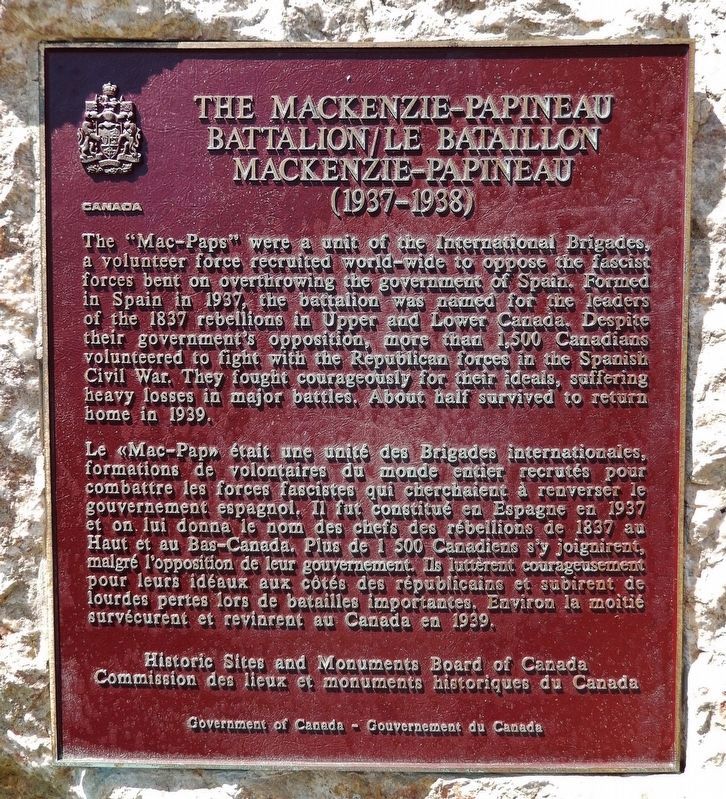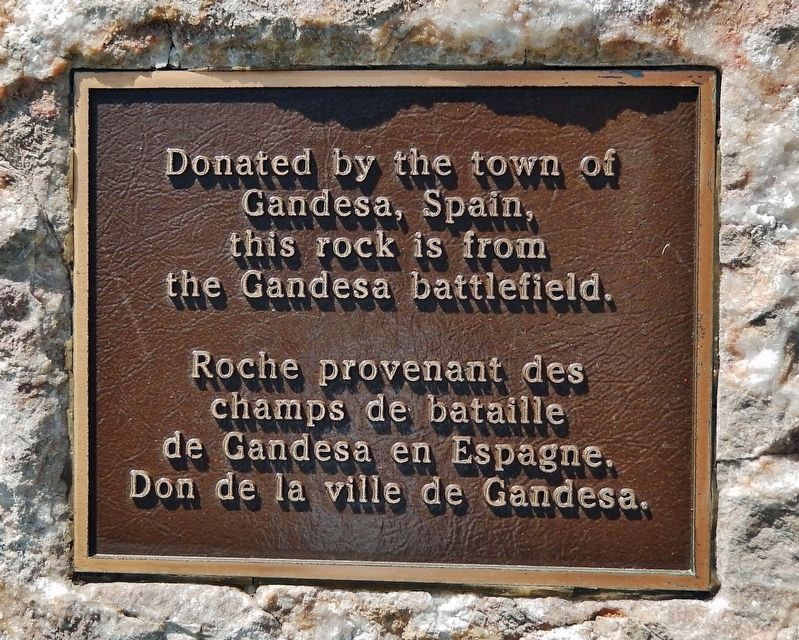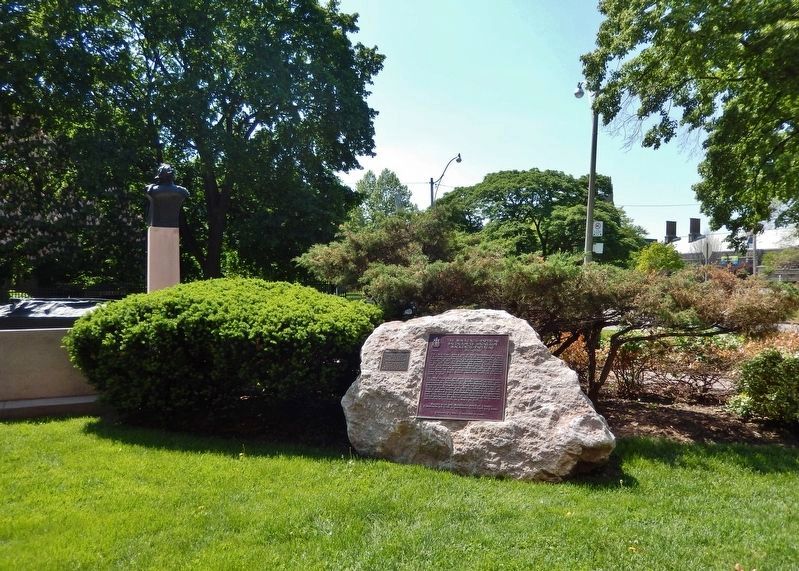Bay-Cloverhill in Toronto, Ontario — Central Canada (North America)
The Mackenzie-Papineau Battalion / Le Bataillon Mackenzie-Papineau
(1937-1938)
The "Mac-Paps" were a unit of the International Brigades, a volunteer force recruited world-wide to oppose the fascist forces bent on overthrowing the government of Spain. Formed in Spain in 1937, the battalion was named for the leaders of the 1837 rebellions in Upper and Lower Canada. Despite their government's opposition, more than 1,500 Canadians volunteered to fight with the Republican forces in the Spanish Civil War. They fought courageously for their ideals, suffering heavy losses in major battles. About half survived to return home in 1939.
Les « Mac-Paps » était une unité des Brigades internationales, formations de volontaires du monde entier recrutés pour combattre les forces fascistes qui cherchaient à renverser le gouvernement espagnol. Il fut constitué en Espagne en 1937 et on lui donna le nom des chefs des rébellions de 1837 au Haut et au Bas-Canada. Plus de 1 500 Canadiens s’y joignirent, malgré l'opposition de leur gouvernement. Ils luttèrent courageusement pour leurs idéaux aux côtés des républicains et subirent de lourdes pertes lors de batailles importantes. Environ la moitié survécurent et revinrent au Canada en 1939.
Erected 1995 by Historic Sites and Monuments Board of Canada/Commission des lieux et monuments historiques du Canada.
Topics. This historical marker is listed in these topic lists: Patriots & Patriotism • Wars, Non-US. A significant historical year for this entry is 1937.
Location. 43° 39.756′ N, 79° 23.563′ W. Marker is in Toronto, Ontario. It is in Bay-Cloverhill. Marker can be reached from Queens Park Crescent West just south of Wellesley Street West, on the left when traveling south. Marker is located in Queen's Park, near the northwest corner of the Ontario Legislative Assembly building. Touch for map. Marker is at or near this postal address: 111 Wellesley Street West, Toronto ON M7A 1A2, Canada. Touch for directions.
Other nearby markers. At least 8 other markers are within walking distance of this marker. William Lyon Mackenzie (a few steps from this marker); The Royal Tour of 1939 / Le Voyage Royal de 1939 (within shouting distance of this marker); Sir Oliver Mowat (about 90 meters away, measured in a direct line); Hon. John Sandfield Macdonald (about 120 meters away); Hon. George Brown (about 150 meters away); Sir James Pliny Whitney (about 150 meters away); Queen Victoria (about 150 meters away); The Discovery of Insulin (about 150 meters away). Touch for a list and map of all markers in Toronto.
Also see . . .
1. Mackenzie-Papineau Battalion.
In April 1937, the Canadian government had passed the Foreign Enlistment Act, outlawing participation by Canadians in foreign wars. The Mac-Paps were an official embarrassment and thus languished in obscurity until the 1970s, when a number of books, films and plays documented their history. Approximately 500,000 soldiers and civilians died during the Spanish Civil War. Canadian losses were between 400 and 750. When the survivors returned to Canada in early 1939, they were celebrated by well-wishers but received no official welcome.(Submitted on October 13, 2022, by Cosmos Mariner of Cape Canaveral, Florida.)
2. Mackenzie–Papineau Battalion.
Because the Canadian government did not participate in the Spanish Civil War, the volunteers do not have status in military institutions or such national memory. The Canadians who died in the Spanish Civil War are not included in the Books of Remembrance in the Peace Tower. Their sacrifice is not commemorated on federal war memorials or in Remembrance Day services. Those who survived the war are not entitled to veterans' benefits. But since the late 20th century, a group known as the Veterans and Friends of the Mackenzie–Papineau Battalion have gained government permission and installed three monuments to commemorate these veterans. The first monument was erected in Toronto on June 4, 1995 at Queen's Park. The monument is a large boulder transported from the battlefield of Gandesa, Spain. Attached to the boulder is a memorial plaque for the Mackenzie–Papineau Battalion.(Submitted on October 13, 2022, by Cosmos Mariner of Cape Canaveral, Florida.)
Credits. This page was last revised on April 26, 2023. It was originally submitted on October 12, 2022, by Cosmos Mariner of Cape Canaveral, Florida. This page has been viewed 196 times since then and 39 times this year. Photos: 1, 2, 3. submitted on October 12, 2022, by Cosmos Mariner of Cape Canaveral, Florida.


